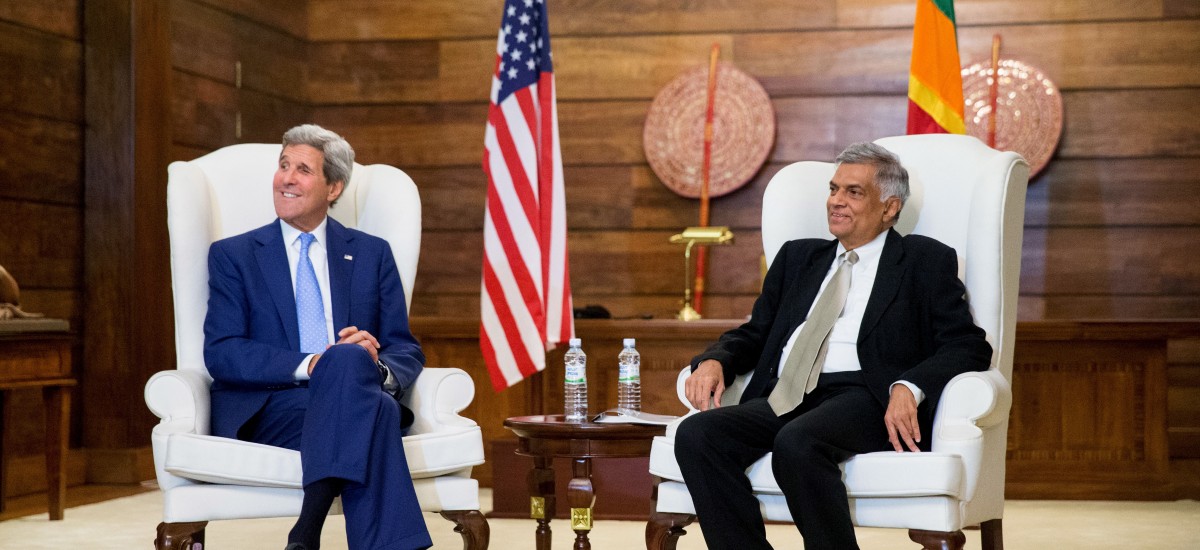Picture courtesy SriLankaBrief
At the turn of the new millennium, South Asia emerged as a region of tremendous international concern. And the South Asian region’s strategic geographical location was important in terms of defining the nature of policies that were to be implemented by the South Asian states as well as those adopted by the external states towards the former.
When preparing the foreign policy of the United States, special consideration is given to the State Department’s construction of the geo-strategic worlds into regional bureaus as they mark the significance of regions. It is formulated as per regions, taking in to consideration the regional dynamics and their interests there. Though initially the South Asian region was hardly given any consideration when the U.S. foreign policy was formulated, this sentiment has been changing over the past forty years or so, as several incidents in the region have featured prominently in the State Department. It is understood that South Asia is obviously an area of special significance due to the growing encounter between the West and Asia. It is ascertained that the South Asian region has become an extremely important component of the United States foreign policy, due to the importance the Indian Ocean has come to play in world politics.
South Asia is also deemed important due to the high-level of terrorist activities in the region and more so because both India and Pakistan possess nuclear weapons and the U.S. perceives this as a threat to their national security. As a result, the U.S. has been heavily involved in the region, especially in Afghanistan and Pakistan to reduce the threat this region poses on her domestic security concerns. It is evident that one of the key reasons as to why the United States is involved in this region is due to their national interests.
However moving forward, the U.S. needs to focus on strengthening ties with the ‘other’ South Asian states, especially Nepal and Bangladesh. For example, the U.S. can now play a large role in the rebuilding efforts taking place in Nepal after the massive earthquakes. With U.S.’ track record in the energy industry, it can get involved and invest in Nepal’s energy sector, thus enabling its expansion (Hoagland, 2015). The United States can further work closely with Sri Lanka to ensure and expand on maritime security ensuring the safety and security of the Sea Lines of Communication (SLOC). This has been a very pronounced need for the United States and a better rapport with the latter could assist the former secure its interests in the Indian Ocean Region (IOR). Implementing the 1971 Declaration of the Indian Ocean as a Zone of Peace will further assist in the ensuring global trade and oil shipments are secure and the IOR is devoid of terrorist and pirate attacks.
“For the United States, the South Asian region is not only of political interest, but also of economic interest due to the wealth of mineral and natural wealth which these countries control along with its strategic importance” (Senaratne, 2015). And in this context, the U.S. relations with India can further expand its economic and security partnerships. An expansion of this partnership works well as “President Obama and Prime Minister Modi have announced their intention to increase U.S.-India trade five-fold, to $500 billion” (Hoagland, 2015). With regard to expanding relations with Bangladesh, the U.S. can concentrate on the former’s economic growth rate which averages at an annual six per cent.
The new U.S. foreign policy towards the region titled the ‘New Silk Road’ was crafted specifically to reap economic benefits from the region. This vision is a four-pronged strategy to bolster regional connectivity as part of the New Silk Road. These four are creating regional energy markets that link Central Asia with South Asia; boosting transportation routes and investing in critical infrastructure; improving customs and borders; and linking businesses and people (Senaratne, 2015).
Furthermore, the United States can play a decisive role in the South Asian Association for Regional Corporation (SAARC) by taking advantage of its observer status. It can drive economic cooperation within the region whilst advocating transparency and legal certainty.
As an external power in the region, the United States can play a significant and crucial role in the future not merely in terms of regional security and economic growth. It can assist in pacifying and promoting regional cooperation and integration as well. It can continue to strive to achieve its interests in the region whilst ensuring the region too grows with the economic giant from the West.
Bibliography
Embassy of the United States in Sri Lanka and Maldives. (2015, February 02). Statement by Assistant
Secretary for South and Central Asia Nisha Biswal at Sri Lanka Ministry of Foreign Affairs. Retrieved from http://srilanka.usembassy.gov/tr-2feb15.html
Evans, A. (2012, December). United States and South Asia after Afghanistan. Asia Society: New York.
Hoagland, R. E. (2015, June 2). Developments in South and Central Asia. Department of State. Retrieved from http://www.state.gov/p/sca/rls/rmks/2015/243087.htm
Kugelman, M. (2014, January 15). Five Resolutions for U.S. South Asia Policy in 2014. Foreign Policy. Retrieved from http://foreignpolicy.com/2014/01/15/five-resolutions-for-u-s-south-asia-policy-in-2014/
Senaratne, B. (2015, February 08). Biswal’s visit and its geopolitical importance. Ceylon Today. Colombo, p. 02.

